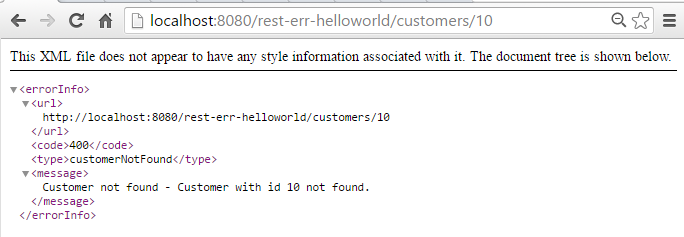
REST API and Error Handling
Most developers don’t think of errors and exception handling while designing a REST API. However it is very critical from your API user perspective as the whole logic inside your API code is black boxed from them. If your API returns an error, the API user should be able to make sense of it so as to take any corrective action. If you want your API to be intuitive and useful, you should adhere to following rules:
- Return relevant HTTP status codes. There are more than 60 status code, but lot of them are either confusing or not common. Use a small subset of status codes which are well known. For example, Google GData API uses 10 status codes, Netflix uses 9, and Digg uses 8. You can find more here.
- Make you error response as human readable as possible. The user of your API doesn’t want to know about your internal errors. They don’t want to see any exception stack or any other gobbledygook.
Here I will explore the second good practice where error responses are human readable. Spring provides a few different ways to handle exceptions but I will restrict my discussion to @ExceptionHandler and @ControllerAdvice. It is the continuation of REST with Spring example. The source code can be found here.
Controller Specific Exception Handling
Any method declared with @ExceptionHandler annotation allows one to handle exception at the controller level. It handles any exception thrown by a request handling method, i.e., any method declared with @RequestMapping annotation. For example, handleTypeMismatchException method in CustomerServiceController handles TypeMismatchException exception. This method is not used for handling exceptions at the application level. Here are the requirements for controller specific exception handling method:
-
Declare the method with
@ExceptionHandlerannotation. -
@ResponseStatusannotation is optional and is usually used for user defined exception. -
Method signature is flexible. It can take zero parameters or take any servlet related objects as parameters. In this example, the
handleTypeMismatchExceptionmethod takesHttpServletRequestandTypeMismatchExceptionas parameters. -
The method doesn’t have to return a value. If the error message needs to be customized to make it more human readable, the method should return a value. @ResponseBody is needed if the method returns a value. Since the return value of the method is serialized and used as a part of the response body, make sure that the returned object class is serializable by using JAXB annotations.
In this example, the error message is localized by using MessageSource. The error messages are stored in the properties file based on locale. A single properties file names messages_en_US.properties is stored in locale folder under resources.
error.customer.id=Customer cannot have id: {0}
error.customer.not.found=Customer not found - {0}
ResourceBundleMessageSource bean needs to be configured in the rest-dispatcher-servlet.xml file to pickup the properties file.
In the example, the returned object class ErrorInfo takes the request URL, response code, error type, and error message as parameters.
Now if a wrong format customer id is used while retrieving a customer, e.g. ‘abc’ instead of a numeric value, the following error message will be displayed in the browser. 
Application Specific Exception Handling
Any POJO class declared with annotation @ControllerAdvice allows one to handle exceptions at the whole application level and is not restricted to any specific controller. In this example, the class ExceptionProcessor handles the exceptions at the application level.
Exception Handing Method
The method handleCustomerNotFoundException is used to handle CustomerNotFoundException exception. This method is not required to return any value or take any parameters. However it can return a value and can take parameters if it’s needed. Here is a list of requirements for an exception handling method:
-
A method should be annotated with
@ExceptionHandler. It takes the exception class as a parameter that is to handled by the method. It maps a specific exception to an appropriate exception handling method. -
@ResponseStatusannotation (which supports all the HTTP status codes defined by the HTTP specification) is used if it’s not already defined in the exception class. It takes response value and reason as parameters. The reason parameter is optional. It allows one to customize the response code based on the requirements. -
Method signature is flexible as earlier. It can take zero parameters or take any servlet related objects as parameters. In this example, the
handleCustomerNotFoundExceptionmethod takesHttpServletRequestand CustomerNotFoundException as parameters. -
Return value is optional as earlier but having a a return value makes the error response more human readable.
@ResponseBodyis needed if the method returns a value.
Now if you try to look up a customer which doesn’t exist, you will get the error message shown below.
